Aston University - Simple English Wikipedia, the free encyclopedia
 | |
| Motto | Forward |
|---|---|
| Type | Public |
| Established | 1895 (granted University Status by Royal Charter in 1966)[1] |
| Endowment | £1.41 million (as of July 2018)[2] |
| Budget | £156.8 million (2017/2018)[3] |
| Chancellor | Sir John Sunderland |
| Vice-Chancellor | Alec Cameron |
| Students | 15,500 (2017/18)[4] |
| Undergraduates | 11,935 (2017/18)[4] |
| Postgraduates | 3,565 (2017/18)[4] |
| Location | , 52°29′10″N 1°53′22″W / 52.4860°N 1.8895°W |
| Campus | Urban, 60 acres (24 hectares)[5] |
| Affiliations | ACU CDIO Initiative EUA Universities UK AACSB M5 Universities |
| Website | www |
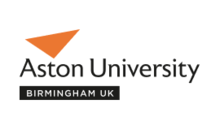 | |
Aston University is a public university in the city centre of Birmingham, England. It received its royal charter from Queen Elizabeth II on 22 April 1966.
Aston is famous for having a placement year as part of many of its undergraduate degree courses.[6] It pioneered the integrated placement year concept from its start in 1966. [7] [8] [9]
History[change | change source]
Predecessor institutions[change | change source]
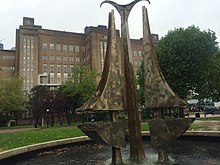
In 1875, a School of Metallurgy was formed in the Birmingham and Midland Institute. In 1895, the Birmingham Municipal Technical School separated from the Institute. It taught chemistry, physics, metallurgy and electrical engineering. In 1911, commercial classes were introduced. By 1916, this had grown into an independent School of Commerce.[11] In 1927, the school changed its name to the Birmingham Central Technical College.[11] This was to reflect its changing approach to teaching technology.
In 1951, the Technical College was renamed the College of Technology, Birmingham.[11] Work began on the Main Building at Gosta Green. Princess Margaret laid one of the first foundation stones at the base of the new building in 1951. The building is said to be one of Europe's largest freestanding brick buildings.[10] In 1956 it became the UK's first College of Advanced Technology.[12] It had a major expansion.[11] The college expanded again to a design by the City Architect of Birmingham Alwyn Sheppard Fidler between 1957 and 1965.[13]
University status[change | change source]
On 22 April 1966, it it was given its Royal Charter. It became the University of Aston in Birmingham. On 10 May 1966, the first Chancellor of the University, Lord Nelson of Stafford, was installed. The Charter of the University outlines its objectives. These are appropriate to a technological university:
"to advance, disseminate and apply learning and knowledge by teaching and research, for the benefit of industry and commerce and of the community generally: and to enable students to obtain the advantage of a university education, and such teaching and research may include periods outside the University in industry or commerce or wherever the University considers proper for the best advancement of its objects."
Due to the history of the institution, there is emphasis given to the sandwich course system and the maintenance of strong links with industry. The motto of the University is the same as that of the City of Birmingham – Forward.[1]
In 1983, Aston University, Birmingham City Council, and Lloyds Bank, established Birmingham Technology Ltd.. This company manages the Aston Science Park. The science park is next to the university site. In 1984, the area was granted its own postal address "The Aston Triangle". This made the campus an official district of Birmingham. The logo of the establishment takes from the shape of the area.[14]
2000 to present[change | change source]
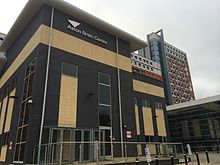
In September 2010, Aston University hosted the British Science Festival. This is one of Europe's largest public science events.[15][16] Since May 2011, Sir John Sunderland has been the Chancellor. The university is a lead sponsor of Aston University Engineering Academy. This university technical college (UTC) opened in September 2012. The UTC is for students aged 14 to 19 wishing to study and have a career in engineering. It is located at the edge of the Aston University campus.[17]
In October 2014, the University announced a £35 million cash injection for a major upgrade of the campus. This included a new £19 million revamp of Aston Business School and improvement work to the Aston Institute of Photonic Technologies and the School of Languages and Social Sciences.[18] In October 2015, Aston launched the Aston Medical School.[19] This was for postgraduate research students. In September 2018 the first Bachelor of Medicine MBChB course started.[19] The course takes five years.
In February 2017, the University launched its online programme website. Four MSc programmes are offered 100% online to students in the UK and worldwide. It also offers the Aston Business School's MBA.[20] In July 2017, Aston became the first University in the UK to award degree apprenticeship graduates.[21][22] Aston began working in close partnership with Capgemini, to create the first degree apprenticeship: Digital and Technology Solutions in 2012.[23]
Campus[change | change source]
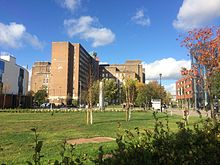
The university sits on a 40-acre campus at Gosta Green, in the city centre of Birmingham, England.[24] The campus has accommodation for over 3000 students. It has sports facilities, a library, cafés, restaurants, pubs, shops, travel centre, hairdresser, health centre, dentist, places of worship, opticians, a bank, automated teller machines and outside leisure space.
Library[change | change source]
Aston University Library is on four floors. It contains over 250,000 books and 800 current printed periodicals. It has over 700 reader places. It provides online access over 3,400 electronic journals. The Library is open 24 hours a day to Aston students and staff during exam time,and 12 hours a day during term time.
IT[change | change source]
Around the campus there are open-access IT suites. They offer computer and internet access 24 hours a day. They offer access to software packages, database systems and computer-aided learning materials.
Sports[change | change source]
Aston University sports facilities include a 25m swimming pool, sauna and steam room, two sports halls, a gym, weights and fitness rooms, and a two storey dance studio. It has 35 sports clubs. The campus also has two floodlit sports pitches. Many of the University clubs train and compete in the British Universities and Colleges Sports (BUCS) Leagues. Away from the campus, the University manages a 40-acre sports ground with floodlit pitches and a pavilion for all outdoor sports.
Organisation and administration[change | change source]
Faculties and departments[change | change source]
All of the Aston University's faculties are based on one campus. They are organised into the following five schools:
- School of Engineering and Applied Science
- Applied Physics
- Chemical Engineering & Applied Chemistry
- Computer Science
- Electronic Engineering
- Engineering Systems and Management
- Mathematics
- Mechanical Engineering and Design
- School of Life and Health Sciences
- Audiology
- Biology
- Biomedical Science
- Optometry
- Pharmacy
- Psychology
- School of Languages and Social Sciences
- Modern languages & translation studies
- International relations, politics & European studies
- English language
- English literature
- History
- Sociology & public policy
- Aston Law
- Economics and Strategy
- Finance and Accounting
- Marketing Group
- Operations and Information Management Group
- Work and Organisational Psychology
Coat of arms[change | change source]
The university's arms were granted on 18 March 1955 by Garter, Clarenceux and Norroy and Ulster Kings of Arms to the Birmingham Corporation. This was for use by the former College of Technology. They were designed to show the College's connection with the City and with the teaching of technology. The arms consist of a shield and crest.
The shield has two sections – the field (the main background) and a chief (the broad band across the top of the shield). The field is coloured blue. The chief is coloured silver. On the field is a diagonal line of five gold diamonds joined one to the other. This is similar to the first quarter of the Arms of the City of Birmingham. It is incorporated in the Arms of the College to show its connection to the City. On the chief is depicted an open book bound in red placed between two black hammers. This shows the connection of the University with technology. The book represents learning. The hammers represent engineering and allied trades.
The crest is designed to stress the pursuit of knowledge. It consists of a red torch held erect by a forearm between two branches of gold laurel. Originally it would have been worn on the helmet of a fully armed person. The crest is always placed on the top of the helm. The method of joining the crest to the helm was usually concealed by decoration. In the University's arms this is done by the use of a wreath and a crown. The wreath is silver, red, and black. These colours being taken from the shield. On top is a mural crown (resembling a wall). This is reserved in modern grants for persons and organisations connected with public corporations. The cloth mantling hangs down from the top of the helm. This represents the cloak which was originally worn to protect the armour. It is coloured blue and gold. These being the two principal colours of the shield.[25]
In 2016, Her Majesty's College of Arms granted the favour of supporters to Aston University's arms. This marked the 50th anniversary of the University. Professor Julia King, the Baroness Brown of Cambridge, the Vice-Chancellor, had made the request. The Letters Patent was formally presented to Aston University by the York Herald, Michael Peter Desmond O'Donoghue Esq.. This was made in a service at St Phillips Cathedral, Birmingham, on 29th September 2016.
The arms are supported by a Canada goose and a red squirrel. The Canada goose is a symbol. It represents the family of geese living on the University campus. The squirrel is the crest of the arms of Aston Manor. This is a rebus. (The picture is a pun on the persons name. The owners of Aston Manor were the Holte family and a squirrel's nest is called a holt). This explains the ancient connection between the squirrel and Aston. The animal also appears on the University mace. It also appears on the Chancellor's chain of office. This chain was originally the property of the Mayor of Aston Manor.
The gorse around the animals' necks is a reference to Gosta Green. It was known as Gostie Green during the 18th century. This combined the name of the landowner (William de Gorsty) with the local plant called 'gorse' [26]
Academic dress[change | change source]
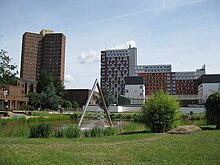
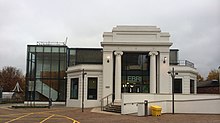
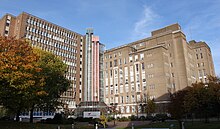
The academic dress for graduates of the University is as follows:
- Bachelor of Science, Bachelor of Engineering and Master of Engineering
- Gown: Black stuff of special design, having coat-type sleeve, narrow facings which continue round the neck and with extra wide gathers round the back
- Hood: Black stuff, modified simple shape, faced inside for three inches with University lining
- Hat: Black mortar board
- Master of Science
- Gown: Black stuff of special design, having coat-type sleeve, narrow facings which continue round the neck and with extra wide gathers round the back
- Hood: Black stuff, modified simple shape, fully lined with University lining
- Hat: Black mortar board
- Master of Philosophy
- Gown: Black stuff of special design, having coat-type sleeve, narrow facings which continue round the neck and with extra wide gathers round the back
- Hood: Blue stuff, modified simple shape, fully lined with University lining
- Hat: Black mortar board
- Doctor of Philosophy
- Gown: Claret colour cloth robe, having coat-type sleeve, narrow facings which continue round the neck and with extra wide gathers round the back
- Hood: Modified simple shape, in University Red stuff, faced inside for three inches with University lining
- Hat: Black cloth bonnet with cord and tassels of University Red
- Doctor of Science
- Gown: Same shape as for Doctor of Philosophy but in University Red, with facings on collar of University lining and gold cuffs on sleeves
- Hood: Same shape as for Doctor of Philosophy but of gold silk and fully lined with University lining
- Hat: Black velvet bonnet with cord and tassels in gold
Academic profile[change | change source]

Research[change | change source]
In the 2008 Research Assessment Exercise, Aston University was ranked in the top 12 in the UK in all four of its broad subject areas. Of the research undertaken, 86% was described as 'internationally significant'.[27] 88% of Aston academic staff were submitted for research assessment. This is one of the highest proportions in the UK. According to the Research Assessment Exercise, the university's strengths include Business and Management, General Engineering, subjects allied to Medicine (Optometry, Biology, Pharmacy and Psychology), Languages and European Studies.
Rankings[change | change source]
In the 2012 QS World University Rankings, graduate employers ranked Aston University 51st for graduate employability.[28] Aston was ranked in the top ten of all UK universities for its graduate employment record.[6]
In 2012, Aston University was responsible for educating 2.3 per cent of the UK's millionaires. This placed Aston at number 8 in the UK.[29]
In 2015, Aston was ranked as the 42nd best university in the world under 50 years old. [30]
For 2018, it was put in the top 55 universities in the UK. It was ranked 18th for student experience in the Sunday Times Good University Guide.[31]
Aston is ranked 34th in the University League Tables 2020.[6]
Aston Business School[change | change source]
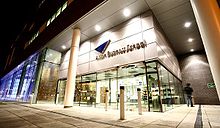
Founded in 1947, Aston Business School (ABS) is one of the largest and oldest business schools in the UK.[32]
In 1999, ABS was the first UK business school to be awarded the prestigious EQUIS accreditation.[33]
The school's most recent Research Assessment Exercise was in 2008. All research areas submitted ranked in the top 12 in the UK. 45% of the research submitted was judged to be "excellent" or "world-leading".[27]
In 2012, the business school's Masters Management course was ranked by the Financial Times as 36th in the world.[34]
In 2014, Aston was 2nd in the UK for developing marketing professionals, 7th for finance professionals,23rd for accounting professionals. This was based on the career outcome data of more than 313 million LinkedIn members.[35]
In 2019, Aston is in the top 1% of Business Schools Worldwide with Triple Accreditation (AMBA, AACSB and EQUIS). It is in the World Top 100 Universities for Business and Management Studies (QS Ranking 2019).[36]
Student life[change | change source]

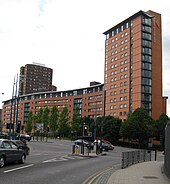
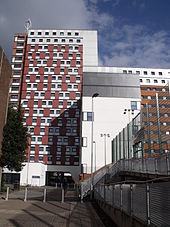
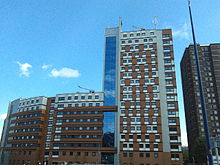
Students' Union[change | change source]
Aston Students' Union (SU) used to be called Aston Guild of Students. It is a non-profit independent charity. It was set up to represent and support its members. Most members are current students at Aston University. The SU operates a number of commercial and non-commercial services. These include; the Advice & Representation Centre (ARC), the Aston Athletic Union, the Aston Societies Federation, the SU Shop, Copyshop and B4 Bar. The Aston Athletic Union supports the university sports clubs. The Aston Societies Federation supports non-sporting societies.
The SU is funded by grant income from Aston University. This is added to by funds raised by the SU's commercial services. The SU is led by a Trustee Board of elected students and external trustees. Day-to-day management is by a team of permanent staff and the Executive Committee. The Executive Committeeby is an elected student team.
The SU building consists of 5 floors and is located in the centre of the Aston University Campus.
On 29 November 2006, the students voted to disaffiliate the Guild (now Union) from the National Union of Students. On 26 November 2014, they voted to re-affiliate.[37]
Student housing[change | change source]
In the 1970s, three tower blocks containing student accommodation were constructed on Aston University campus. They were named Dalton, Lawrence and Stafford Towers. In August 1999, the Lakeside complex added further student accommodation on to the campus.
In April 2007, Aston University submitted a planning application for demolition of the three 1970s towers. They were to be replaced by new student accommodation blocks, apartments for tutors, retail units and administrative offices. On 8 May 2011, Lawrence and Dalton Towers were demolished.[38] On 27 April 2014, Stafford Tower, Gem Sports Centre and Lakeside Conference Centre were demolished. This made way for a new entrance to Aston University and a five-acre green space. The new landscaped area includes a walkway into the university from the city centre. It also contains a pavilion for teaching. The pavillion is also used as a catering facility for outdoor events. The new buildings are named the William Murdoch, the James Watt, the Harriet Martineau and the Mary Sturge Residences.[39]
In 2016, Aston sold all of the student housing that it owned to UNITE Students.
Notable people[change | change source]
Chancellors[change | change source]
- Lord Nelson of Stafford (May 1966 – September 1979)
- Sir Adrian Cadbury (September 1979 – September 2004)
- Michael Bett (September 2004 – May 2011)
- John Sunderland (Since May 2011)
Vice-Chancellors[change | change source]
- Peter Venables (April 1966 - July 1969)
- Sir Joseph Pope (August 1969 - September 1979)
- Frederick W. Crawford (July 1980 - August 1996)
- Michael T. Wright (September 1996 - November 2006)
- Dame Julia King (November 2006 – September 2016)
- Alec Cameron (September 2016 – Present)
Lecturers[change | change source]
- Prof. Geoffrey Vernon Ball - The first full-time lecturing professor of ophthalmics, (1948-1981)
Alumni[change | change source]
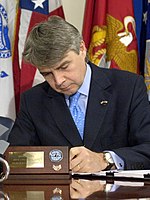
- Chris Banks, British businessman
- Keith Bradley, Baron Bradley, Labour Party politician and life peer
- Rob Brighouse, Managing Director Chiltern Railways[40]
- Frankie Boyle, Stand-up, Television
- Rūta Bunkutė, IFBB/NPC Amateur fitness and figure competitor from Lithuania
- Anthony Cheung, Secretary for Transport and Housing in Hong Kong
- Stewart Clegg, Australian sociologist
- Paul Drayson, Baron Drayson, vaccine manufacturer and Minister of State for Science, Drayson Racing Driver[41]
- Simon D'Ujanga, State Minister for Energy in Uganda
- Veronica German, Scientist, Member of the National Assembly for Wales
- Malcolm Harbour, British politician
- Tony Hayward, Former chief executive of BP Group
- Abdollah Jassbi, President of Azad University
- Laura Jones, BBC Journalist[41]
- Mohammad Nizar Jamaluddin, Former Chief Minister of the state of Perak
- Ravi Kant, Vice Chairman of TATA Motors, India[42]
- Ashok Kumar, Labour Party politician
- Rachel Maclean, Conservative Party politician
- Kevin Morley, Former Managing Director of the former Rover Group
- Ivan Noble, BBC journalist
- Rob Perrins, Managing Director of Berkeley Group Holdings
- Terry Pitt, Political adviser and former Member of the European Parliament
- Phil Popham, Global Operations Director for the global Jaguar Land Rover business
- Rahul Potluri, Founder of ACALM, Doctor, Researcher, Scientist
- John Rickard, Former Chief Economic Advisor to the British Government

- Nic Robertson, Senior International Correspondent at CNN
- Jeff Rooker, Baron Rooker, Labour Peer[41]
- Adam Ryland, British programmer
- Claire Curtis-Thomas, British Labour Party politician and former MP
- Gregor Townsend MBE, Scottish and British Lions Rugby Union Player[41]
- Kate Walsh, Television presenter[41]
- Robert Walter, Conservative MP
- Kevin Warwick, Professor of cybernetics and Deputy Vice-Chancellor (Research) at Coventry University
- Steve Wharton, British academic
- Salma Yaqoob, Leader, and former vice-chairman, of Respect – The Unity Coalition
References[change | change source]
- ↑ 1.0 1.1 "History and traditions". Retrieved 27 October 2019.
- ↑ "Financial Statement 2017-18" (PDF). Aston University. p. 46. Retrieved 27 October 2019.[permanent dead link]
- ↑ "Financial Statement 2017-18" (PDF). Aston University. p. 25. Retrieved 27 October 2019.[permanent dead link]
- ↑ 4.0 4.1 4.2 "Financial Statement 2017-18" (PDF). Aston University. p. 9. Retrieved 27 October 2019.[permanent dead link]
- ↑ "Financial Statement 2017-18" (PDF). Aston University. p. 4. Retrieved 27 October 2019.[permanent dead link]
- ↑ 6.0 6.1 6.2 "Aston University". Complete University Guide. Retrieved 28 October 2019.
- ↑ "Aston University team up with tech firm for IT degree". birminghampost. 8 March 2014. Retrieved 27 October 2019.
- ↑ "50th Anniversary: Sir James Gracie Q&A". Archived from the original on 30 August 2015. Retrieved 27 October 2019.
- ↑ "Engineering graduates for industry" (PDF). Archived from the original (PDF) on 16 July 2015. Retrieved 27 October 2019.
- ↑ 10.0 10.1 "Midlands Business News New era at Conference Aston with the help of Overbury - Midlands Business News". Midlands Business News. Archived from the original on 17 July 2015. Retrieved 28 October 2019.
- ↑ 11.0 11.1 11.2 11.3 "History and Traditions". Aston University. 2008. Archived from the original on 19 December 2008. Retrieved 28 October 2019.
- ↑ Neil Handley. "Birmingham - Central Technical College and Aston University". Archived from the original on 11 July 2016. Retrieved 27 October 2019.
- ↑ Foster, Andy (2007) [2005]. Birmingham. Pevsner Architectural Guides. Yale University Press. p. 195. ISBN 978-0-300-10731-9.
- ↑ "1980s". Aston.ac.uk. Archived from the original on 20 February 2016. Retrieved 28 October 2019.
- ↑ Bagla, Pallava; Binoy, V. V. (17 February 2017). Bridging the Communication Gap in Science and Technology: Lessons from India. Springer. p. 290. ISBN 978-981-10-1025-5.
- ↑ Morris, Andrew James (10 December 2014). Getting To Grips With Science: A Fresh Approach For The Curious. World Scientific. p. 153. ISBN 978-1-78326-594-7.
- ↑ "Aston University | Aston University Engineering Academy". Auea.co.uk. Archived from the original on 17 October 2015. Retrieved 29 October 2019.
- ↑ Jon Griffin (17 October 2014). "New Aston University business school after £35m boost". birminghampost. Retrieved 29 October 2019.
- ↑ 19.0 19.1 "Aston Medical School FAQ". Archived from the original on 23 September 2015. Retrieved 29 October 2019.
- ↑ "The Aston MBA - Aston Business School". Aston University. Retrieved 21 July 2020.[permanent dead link]
- ↑ Offord, Paul (17 July 2017). "First degree apprentices in UK graduate". FE Week. Retrieved 29 October 2019.
- ↑ "First set of Capgemini degree apprentices graduate". ComputerWeekly.com. Retrieved 29 October 2019.
- ↑ Capgemini (7 September 2018). "Creating the first degree apprenticeship in digital and technology solutions". NCUB. Retrieved 29 October 2019.
- ↑ Tarleton, Alice (1 August 2006). "Aston University". The Independent. A-Z Unis & Colleges. London. Archived from the original on 26 September 2006. Retrieved 29 October 2019.
- ↑ "Aston University Arms". Archived from the original on 17 July 2015. Retrieved 30 October 2019.
- ↑ "Aston University". Retrieved 30 October 2019.
- ↑ 27.0 27.1 "Aston's performance in the Research Excellence Framework". Archived from the original on 26 December 2014. Retrieved 1 November 2019.
- ↑ "employable graduates". April 2012. Archived from the original on 27 September 2013. Retrieved 1 November 2019.
- ↑ "Top 10 universities for joining the super-rich". Telegraph.co.uk. 26 July 2012. Retrieved 1 November 2019.
- ↑ "QS World University Rankings 2015". Top Universities. Retrieved 1 November 2019.
- ↑ "Financial Statement 2017-18" (PDF). Aston University. p. 4. Retrieved 27 October 2019.[permanent dead link]
- ↑ "60th Anniversary of Aston Business School". Archived from the original on 16 April 2008. Retrieved 1 November 2019.
- ↑ Nick Pandya (16 February 2002). "Aston Business School". the Guardian. Retrieved 1 November 2019.
- ↑ "Business school rankings from the Financial Times - Aston Business School". Rankings.ft.com. Retrieved 1 November 2019.
- ↑ "Aston rated 'Top 10' in LinkedIn Rankings". Archived from the original on 14 June 2015. Retrieved 16 July 2015.
- ↑ "Aston University enters top 100 world ranking for Business and Management Studies". Retrieved 1 November 2019.
- ↑ "Aston Students' Union re-joins NUS". NUS. Archived from the original on 29 November 2014. Retrieved 1 November 2019.
- ↑ "BBC News - Aston University tower blocks demolished". Bbc.co.uk. 8 May 2011. Retrieved 1 November 2019.
- ↑ "Aston Accommodation". Archived from the original on 25 July 2013. Retrieved 1 November 2019.
- ↑ "Business Directors join Advisory Board". .aston.ac.uk. 5 March 2013. Archived from the original on 2 February 2014. Retrieved 27 April 2014.
- ↑ 41.0 41.1 41.2 41.3 41.4 "Aston University, Birmingham - A-Z Unis & Colleges - Getting Into University". The Independent. 6 June 2013. Retrieved 28 October 2019.
- ↑ "Ravi Kant - Forbes". People.forbes.com. 18 April 2012. Archived from the original on 20 April 2014. Retrieved 27 April 2014.


 French
French Deutsch
Deutsch